How to replace the electronic control board on a top-load washer
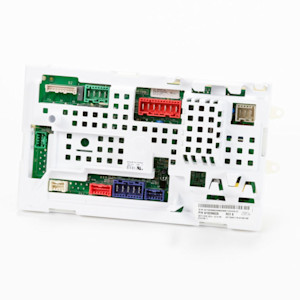
This step-by-step washer repair guide explains how to replace the electronic control board in the console of a top-load washer. The electronic control board is the "brains" of the washer that starts and stops the washer's components, such as the drive motor and the drain pump. If the control board's display doesn't light up, or if the washer doesn't fill, spin, or drain, the electronic control board could be the problem. Because a problem with the control board can be hard to diagnose, we recommend having a local washer repair expert determine the cause. If the electronic control board is faulty, replace it with a manufacturer-approved washer part.
Use this procedure to replace the electronic control board on Kenmore, Whirlpool, Maytag and Amana top-load washers. You also can use the same basic steps to the replace the control board in some LG, Samsung and GE top-load washers.
This video shows how to replace the electronic control board on a top-load washer.
Instructions
- 01.
Shut off the electricity
Unplug the power cord from the wall outlet.
Wear work gloves to protect your hands.
Have someone help you move the washer away from the wall.
- 02.
Remove the control knob
Pull the control knob off of the front of the control panel.
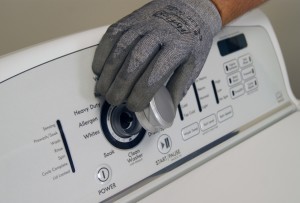
PHOTO: Remove the control knob from the control panel.
- 03.
Open the control console
Remove the 2 screws from the top of the back panel of the console.
Push back on the control panel while sliding a putty knife under the right corner of the control panel to release the mounting clip.
Repeat on the left side to release the console. Set the console on top of the washer.
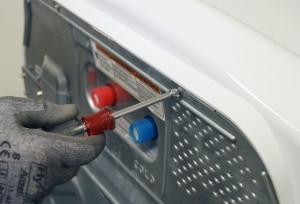
PHOTO: Remove the screws from the console back panel.
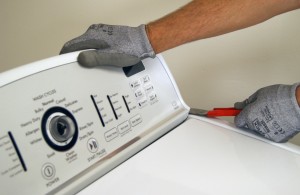
PHOTO: Push back on the console and release the clips.
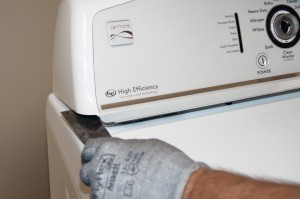
PHOTO: Release the console mounting clip.
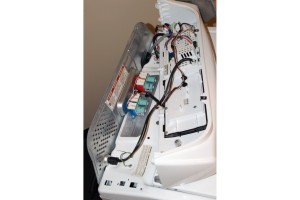
PHOTO: Lay the console on top of the washer.
- 04.
Remove the electronic control board
Take a digital photograph or otherwise document the location of wires connected to the back of the electronic control board.
Release any locking tabs on the wire harness connection plugs and then pull each wire plug out of the connections on the back of the control board.
Disconnect the air hose from the back of the control board.
Remove the mounting screw from the electronic control board.
Release the locking tabs and pull the electronic control board out of the console.
Tip: The other end of the air hose attaches to the bottom of the washer tub. The hose enables the control board to detect the water level.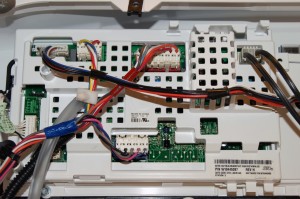
PHOTO: Document the location of the wires connected to the electronic control board.
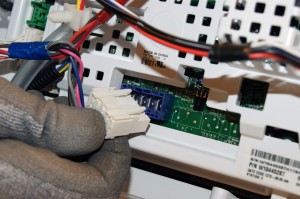
PHOTO: Disconnect the wires from the control board.

PHOTO: Disconnect the air hose from the back of the control board.
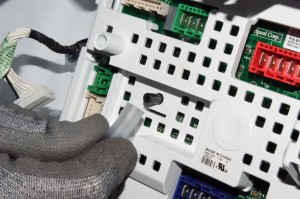
PHOTO: Remove the air hose.
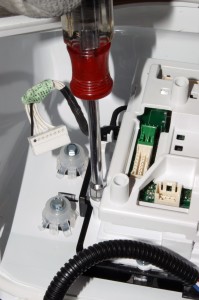
PHOTO: Remove the control board mounting screw.
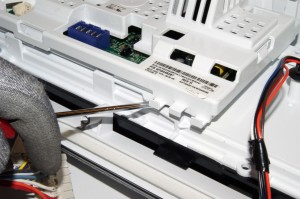
PHOTO: Release the control board locking tabs.
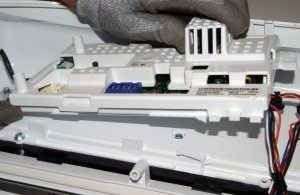
PHOTO: Remove the electronic control board.
- 05.
Install the new control board
Position the new control board in place and snap it into the locking tabs.
Insert the mounting screw in the control board housing and tighten it firmly.
Reconnect the air hose down to the back of the control board.
Using your photograph or other documentation as a guide, connect all the wires to the back of the new control board.
Push the wire harness plugs into the connections on the control board until the locking tabs snap into place.
- 06.
Reinstall the console
Position the console on top of the top panel and snap the mounting clips into place to secure the console on the top panel.
Reinstall the screws at the top of the back panel on the console. Tighten the screws firmly.
Reinstall the control knob.
- 07.
Restore the electrical power
Plug the washer into the electrical outlet.
Return the washer to its original location.
- 08.
Calibrate the washer
With the washer shut off, the basket empty (no water or clothes) and the lid closed, enter the diagnostic mode:
Turn the control dial 1 complete rotation (360 degrees) counterclockwise.
Quickly (within about 6 seconds) turn the control dial 3 clicks clockwise, one click counterclockwise, and one more click clockwise.
All the green status lights blink when you successfully activate the diagnostic mode.
If the status lights don’t blink, turn the control dial one complete rotation counter-clockwise to reset the control and then try again, this time turning the knob faster.
In the diagnostic mode, select the Calibration Cycle by turning the control dial 4 clicks clockwise. When the Rinse light turns on, press Start to begin the Calibration Cycle, which runs for 2 to 3 minutes. When the Calibration Cycle ends, the lid unlocks and the washer shuts off.
Most common symptoms to help you fix your washers
Choose a symptom to see related washer repairs.
Main causes: clogged drain hose, house drain clogged, bad drain pump, water-level pressure switch failure, bad control b…
Main causes: worn agitator dogs, bad clutch, broken motor coupler, shifter assembly failure, broken door lock, suspensio…
Main causes: bad lid switch or door lock, bad timer or electronic control board, wiring failure, bad water inlet valve a…
Main causes: broken lid switch or lid lock, bad pressure switch, broken shifter assembly, faulty control system…
Main causes: unbalanced load, loose spanner nut, worn drive block, broken shock absorber or suspension spring, debris in…
Main causes: no water supply, bad water valves, water-level pressure switch failure, control system failure, bad door lo…
Main causes: lack of electrical power, wiring failure, bad power cord, electronic control board failure, bad user interf…
Main causes: leaky water inlet valve, faulty water-level pressure switch, bad electronic control board…
Main causes: water heater failure, bad water temperature switch, faulty control board, bad water valve, faulty water tem…
Repair guides for top-load washers
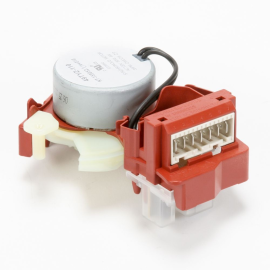
How to replace the shifter assembly in a top-load washer
The shifter motor switches the washer's drive motor between the agitate and spin modes. If your washer's basket won't bu…
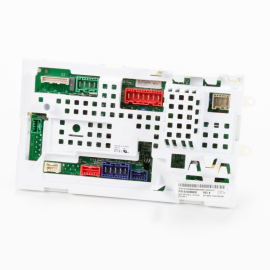
How to replace the electronic control board on a top-load washer
The electronic control board is a major component that orchestrates the washer's functions. These instructions explain h…
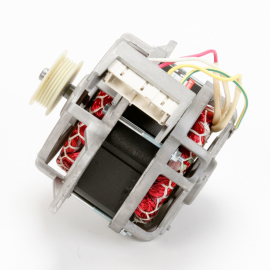
How to replace the drive motor in a top-load washer
The drive motor creates the rotation that turns the spin basket and agitator. If those components won't budge, replace t…
Effective articles & videos to help repair your washers
Use the advice and tips in these articles and videos to get the most out of your washer.
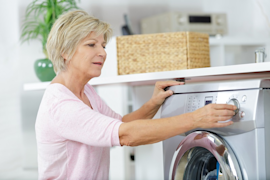
Find tips for using your washing machine efficiently to save energy and help reduce utility bills.…

Learn about all the convenient features on our Sears PartsDirect website that make your parts purchases easier.…

Get answers to frequently asked questions about Sears and Sears PartsDirect.…
